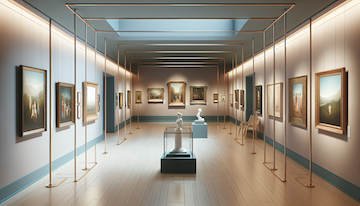You’ve always admired beautiful paintings and sculptures, but did you know that art can be a lucrative investment? In this article, we’ll explore why collecting art is more than just a hobby. Discover how your passion for creativity can potentially lead to financial gains, cultural enrichment and personal fulfillment. Learn about the ins and outs of art investment and why it might be the perfect addition to your portfolio.
Art has long been appreciated for its aesthetic value, but its potential as an investment has gained significant attention in recent years. Collectors and investors alike are recognizing the unique benefits of acquiring artworks, not just for personal enjoyment but also as a means of diversifying their financial portfolios. This shift in perspective has transformed art collecting from a mere hobby into a serious investment strategy.
The Financial Potential of Art Investment
One of the primary reasons people are drawn to art investment is its potential for financial returns. Unlike traditional investments like stocks or bonds, art has the advantage of being a tangible asset that can appreciate in value over time. Many collectors have seen their investments grow substantially, with some artworks fetching millions at auction. And while not every piece will skyrocket in value, a well-curated collection can provide steady returns over the long term.
But it’s not just about the money. Art collecting, like art collection itself, offers a unique blend of personal enjoyment and financial opportunity. Collectors often find themselves deeply engaged in the process of researching artists, attending exhibitions and building relationships within the art world. This involvement can lead to a deeper appreciation of art and culture, enriching the collector’s life in ways that go beyond monetary value.
The Cultural and Personal Benefits of Art Collecting
A Gateway to Cultural Enrichment
Collecting art isn’t just about acquiring objects; it’s about immersing yourself in a world of creativity and cultural significance. As collectors delve deeper into the art world, they often find themselves learning about different artistic movements, historical contexts and the stories behind the artworks they acquire. This journey of discovery can be incredibly rewarding, broadening one’s perspective and deepening one’s understanding of human expression.
Building a Legacy
For many collectors, art investment is also about creating a legacy. A carefully curated collection can be passed down through generations, serving as a testament to the collector’s taste and vision. It can also be a way to support emerging artists and contribute to the cultural landscape, potentially shaping the future of art itself.
Navigating the Art Market: Tips for Aspiring Collectors
Research and Education: The Foundation of Smart Collecting
Before diving into art investment, it’s crucial to educate yourself about the art market. This means studying art history, following current trends and understanding the factors that influence an artwork’s value. Attending art fairs, gallery openings and auctions can provide valuable insights and help you develop your eye for quality and potential.
Building Relationships in the Art World
Success in art investment often depends on building strong relationships within the art community. Connecting with gallery owners, artists and other collectors can provide access to exclusive opportunities and insider knowledge. These relationships can be invaluable in making informed decisions and discovering hidden gems before they hit the mainstream market.
Art collecting is more than just a hobby; it’s a journey that combines financial potential with personal growth and cultural enrichment. While it requires dedication, research and a willingness to take risks, the rewards can be substantial.
Whether you’re drawn to the financial prospects or the joy of owning beautiful works of art, investing in art offers a unique opportunity to engage with creativity on a deeper level while potentially growing your wealth. So why not start exploring the world of art investment? You might just discover a passion that pays dividends in more ways than one.






